These recruitment report templates can make reporting faster and easier. They help you use data better, improve the experience for candidates, and save money. They also make the hiring process simpler and help you track important KPIs to make better hiring decisions.
From sourcing and screening to interviewing and onboarding, let us go over top 10 templates that will help you measure your progress, identify bottlenecks, and optimize your efforts further.
Let’s get started.
What is a recruiting report template?
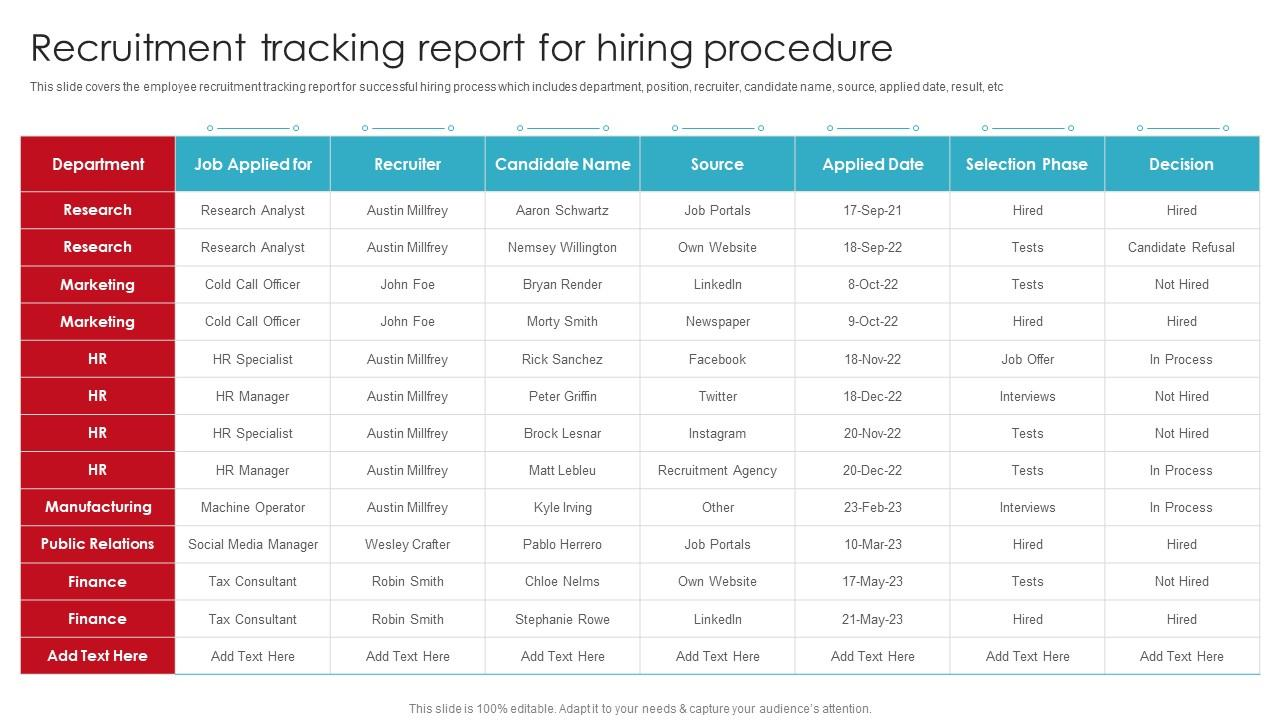
Think of a recruiting report template as your cheat sheet to make sense of all the candidate data you receive. Let’s understand this with an example.
Suppose you’ve posted an opening. You may find dozens, maybe hundreds of applications for the position. Now, you have to be on top of the constant juggling of candidate profiles and tackle the challenge of evaluating your team's performance while measuring the effectiveness of our strategies.
This is a lot to manage, and it's easy to feel buried under a mountain of data.
So, how do you bring order to this chaos?
A well-designed recruiting report template is a framework that helps you consistently capture, organize, and analyze your hiring data. It's designed to highlight the metrics that matter most to your organization, whether that's time-to-hire, cost-per-hire, or quality of candidates.
A great template doesn't just show you what happened. It helps you understand why it happened and, more importantly, what you should do next.
To put it simply, it's the difference between saying, "We hired 10 people last month" and "Our engineering hires are taking 20% longer than other departments, and here's why."
Top metrics to include in a recruitment dashboard
Here are the most important metrics for which you should have go-to templates:
1. Time-to-hire
This is the average time it takes from when a candidate enters your pipeline to when they accept an offer. You can break it down into stages:
- Time to screen: How long does it take your team to review applications?
- Time to first interview: Are you quick to engage promising candidates?
- Time between interviews: Is your process dragging on unnecessarily?
- Time to offer: Once you've decided, how fast can you pull the trigger?
By tracking each of these, you can pinpoint bottlenecks. Take, for instance, a company whose time between interviews was sky-high. Turns out, their hiring managers were swamped and couldn't schedule follow-ups. Tracking the right metrics can help them implement a new scheduling system and cut their overall time-to-hire.
Compare your time-to-hire across different roles and departments. You might find that some positions consistently take longer to fill, which could indicate a need to adjust your sourcing strategy or job requirements for just that kind of role.
2. Source of hire
This tracks where your successful candidates are coming from. But don't just look at the raw numbers. You need to analyze:
- Quality of hires from each source: Are referrals outperforming job board hires?
- Cost-effectiveness: Which sources give you the best ROI?
- Time-to-hire by source: Do candidates from certain sources move through your pipeline faster?
As an all-in-one solution for modern hiring teams, Kula ATS has built-in source tracking that follows candidates from application to offer of employment. This allows you to see not just where candidates are coming from but which sources are producing your best hires.
A tech startup has been pouring money into expensive niche job boards. When they dug into their data, they found that their best engineers were coming from hackathons and coding competitions, not niche job boards. Subsequently, they shifted their strategy and saw a 40% increase in the quality of technical hires.
3. Offer acceptance rate
This is the percentage of candidates who accept your job offers. But there's more to it than just that number. You should be looking at:
- Acceptance rate by role: Are certain positions harder to close?
- Acceptance rate by recruiter: Do some team members have a knack for closing deals?
- Reasons for declined offers: Is it always about money, or are there other factors?
With Kula ATS, you’ll find it easy to track the journey of every applicant, including the ones who reject your offers. This has been eye-opening for many companies.
For example, one client discovered that their lengthy hiring process was causing candidates to lose interest.
4. Quality of hire
This is arguably the most important metric but also the trickiest to measure. Here's how to break it down:
- Performance ratings: How do new hires score in their first year?
- Retention rate: Are your new hires sticking around?
- Time to productivity: How quickly are new hires getting up to speed?
- Hiring manager satisfaction: Are the people who requested the hire happy with the result?
Kula ATS offers granular insights into each job opening's performance. You can use this to adjust your screening criteria and, ultimately, tweak who you choose to hire in the future.
5. Diversity metrics
These aren’t just about meeting quotas. A truly useful diversity metric should cover the following:
- Diversity of applicant pool: Are you attracting a diverse range of candidates?
- Diversity at each stage of the hiring process: Where are diverse candidates dropping off?
- Intersectionality: Are you considering multiple aspects of diversity?
- Inclusion scores: Once hired, do diverse employees feel included and engaged?
Kula ATS has built-in features that track these metrics without collecting sensitive personal data or revealing identities. It's a delicate balance, but it's crucial for building truly inclusive workplaces.
6. Cost-per-hire
This metric can be an eye-opener. It should include:
- Direct costs: Job board fees, agency fees, relocation expenses, signing bonuses
- Indirect costs: Time spent by recruiters and hiring managers, interview expenses, assessment tools
But don't just look at the overall number. Break it down by:
- Role: Do some positions cost more to fill than others?
- Source: Which channels give you the best bang for your buck?
- Time: Are your costs increasing or decreasing over time?
Kula ATS has built-in cost-tracking features that automatically calculate these metrics.
One company was shocked to find that their "cheap" method of hiring through job boards was costing them more than using a specialized recruiter. This happened when they factored in all the time their team was spending screening unqualified candidates.
7. Candidate experience score
This gauges how candidates feel about your hiring process. To measure it effectively, you need to:
- Survey candidates at multiple stages, not just at the end
- Ask about specific aspects of the process (application, interviews, communication)
- Include both successful and unsuccessful candidates
- Track trends over time
Kula ATS has a built-in feedback system that automatically sends out these surveys and compiles the results.
As a case in point, one company discovered that their automated rejection emails were leaving a bad taste in the candidates’ mouths. They rewrote them to be more personal and saw their Glassdoor ratings improve within a few months.
Remember, these metrics are most powerful when used together.
A low time-to-hire means nothing if your quality of hire suffers. A high offer acceptance rate isn't great if it's costing you a fortune. The key is finding the right balance for your organization's needs and goals.
Overview of top 10 recruitment report templates
Let's take a look at the top 10 recruitment templates and how they can make your job easier:
1. Human resource recruitment report with monthly metrics template
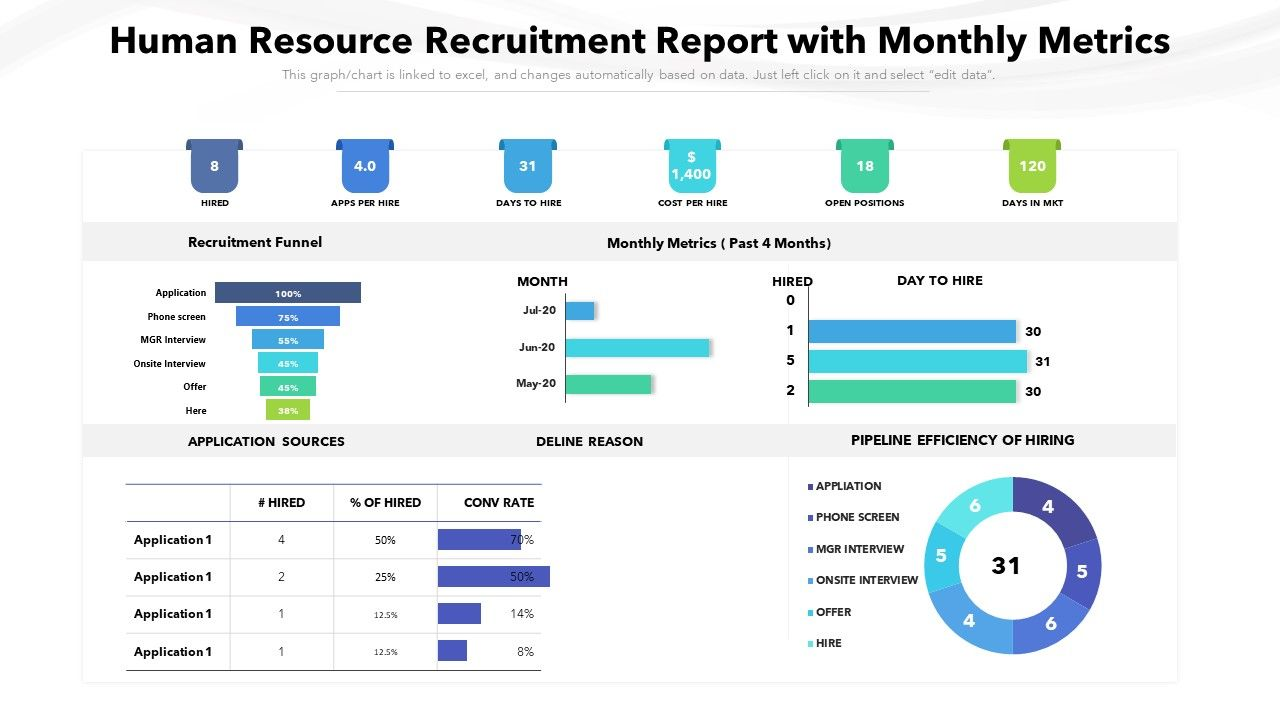
This is your go-to for a comprehensive overview of recruitment activities. It's like a monthly health check for your hiring process.
Use this to identify a pattern in your time-to-fill metrics. Are you losing candidates due to a lengthy approval process? Do hiring managers struggle with booking interviews due to endless back-and-forths when arriving at a date (Kula ATS has an in-built feature that fixes this)?
Benefits:
- Identifies hiring trends over time
- Helps optimize recruitment channel spending
- Provides clear ROI on hiring efforts
- Enables data-driven adjustments to hiring strategies
Implementation tip: Set up automated data collection wherever possible. This could involve integrating your ATS with other HR systems or using tools that can pull data from multiple sources.
Potential challenge: Information overload. With so much data available, it's easy to get lost in the details.
Solution: Focus on 3-5 key metrics that align with your current recruitment goals. Rotate these focus areas quarterly to get a well-rounded view over time.
Process example: Some organizations use this report in monthly recruitment strategy meetings. They review the past month's data, celebrate wins (like reducing time-to-hire), and set goals for the coming month based on the insights gained.
2. Monthly recruitment process report of job positions template
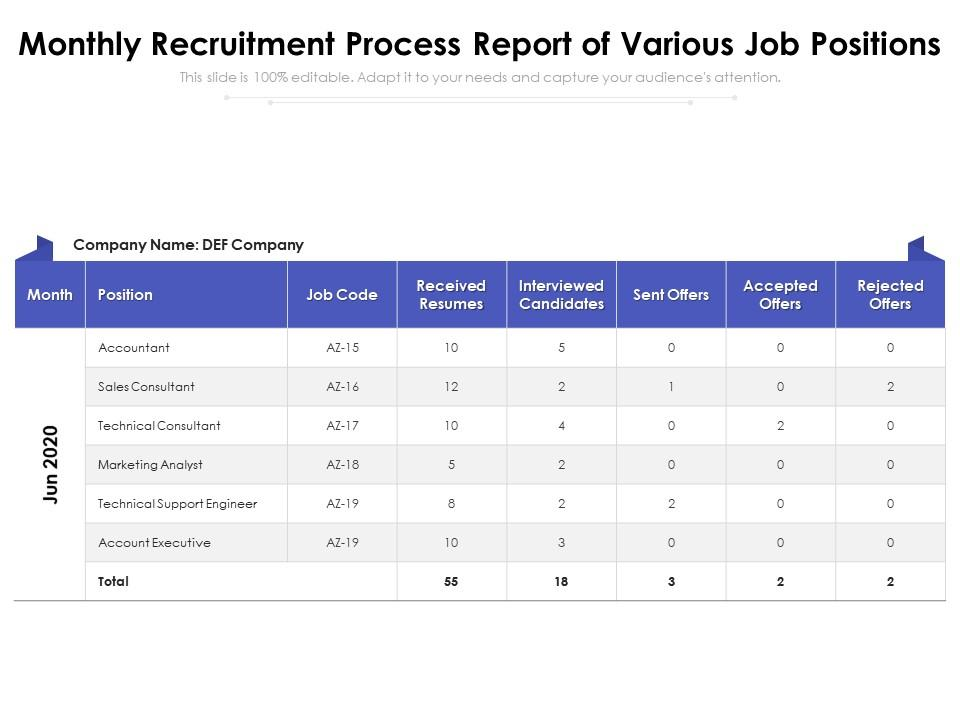
This one tracks job openings across different roles. It helps you pinpoint bottlenecks, refine your sourcing strategies, and boost recruitment efficiency. It's a lifesaver for keeping your hiring on track.
You can use this to spot a trend in hard-to-fill positions. You may realize certain roles always take longer to fill, so you can start recruiting for those proactively. Game-changer.
Benefits:
- Pinpoints bottlenecks in hiring for specific positions
- Helps refine role-specific sourcing strategies
- Improves overall recruitment efficiency
- Allows for better resource allocation across open positions
Implementation tip: Create a standardized process for updating this report. Assign team members to specific roles or departments to ensure consistent and timely updates.
Potential challenge: Difficulty in comparing different roles or departments due to varying hiring needs.
Solution: Develop role-specific benchmarks and use these for comparisons rather than comparing roles directly against each other.
Process example: HR teams often use this report to conduct quarterly reviews with department heads. They analyze trends in hard-to-fill positions and collaboratively develop strategies to improve recruitment for these roles.
3. Recruitment analytics report summary with workflow status template
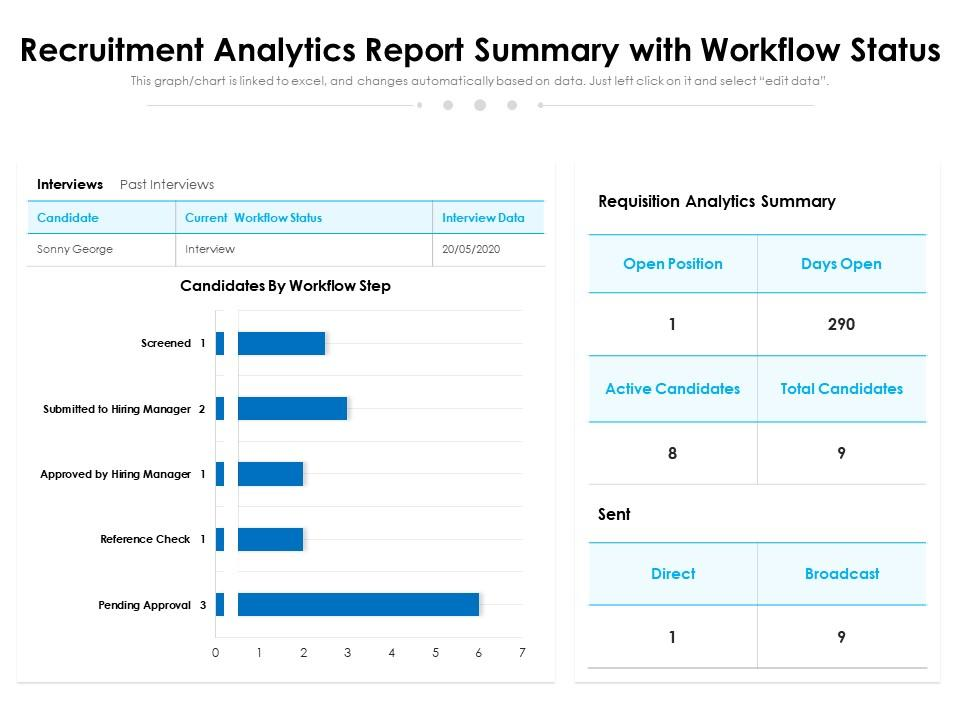
Think of this as your recruitment pipeline dashboard. It gives you real-time insights into where candidates are in the process, helping you identify gaps and areas for improvement. It's crucial for optimizing your hiring workflow.
Say you’re a tech startup that used this and realized your technical interviews were causing a major slowdown. You can implement a more efficient coding challenge and double pipeline speed.
Benefits:
- Provides visibility into each stage of the hiring process
- Helps identify and address workflow bottlenecks
- Enables quick adjustments to improve candidate flow
- Supports more accurate hiring timeline predictions
Implementation tip: Integrate this report with your ATS to get real-time updates on candidate status changes. This ensures you're always working with the most current data.
Potential challenge: Identifying the root causes of bottlenecks in the recruitment process.
Solution: Use this report in conjunction with qualitative feedback from recruiters and hiring managers to get a complete picture of what's causing delays.
Process example: Some companies use this report in weekly stand-up meetings with the recruitment team. They review the current state of the pipeline and make quick decisions on where to focus their efforts for the week ahead.
4. Weekly recruitment report with candidate status template
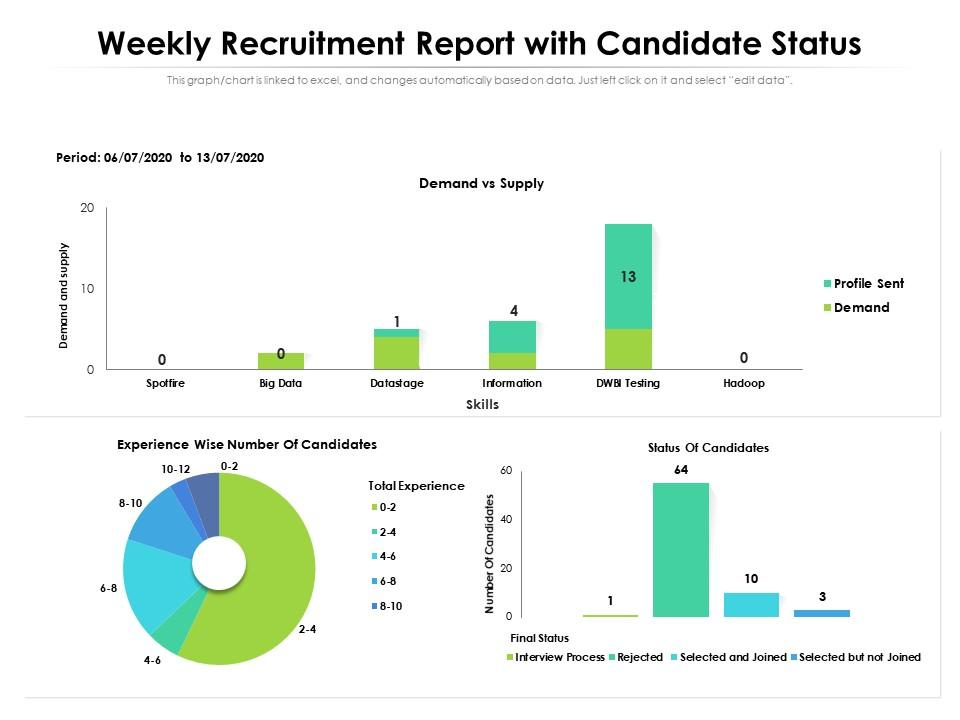
This is your weekly pulse check. It shows you the status of candidates in your pipeline, the interview stages, and offer acceptance rates. It's perfect for keeping your team aligned and making quick adjustments to your hiring tactics.
It keeps everyone accountable and helps catch issues before they become problems.
Benefits:
- Maintains team focus on immediate hiring priorities
- Facilitates quick interventions for at-risk candidates
- Improves communication between recruiters and hiring managers
- Helps track progress toward weekly and monthly hiring targets
Implementation tip: Automate the generation and distribution of this report to ensure it's delivered to key stakeholders at the same time each week.
Potential challenge: Keeping the report concise while still providing all necessary information.
Solution: Use visual elements like charts or graphs to convey information quickly. Include an executive summary highlighting the most critical points.
Process example: Recruitment teams often use this report to kick off their week. They review it every Monday morning to set priorities and allocate resources for the coming week.
5. Agency recruitment annual report template
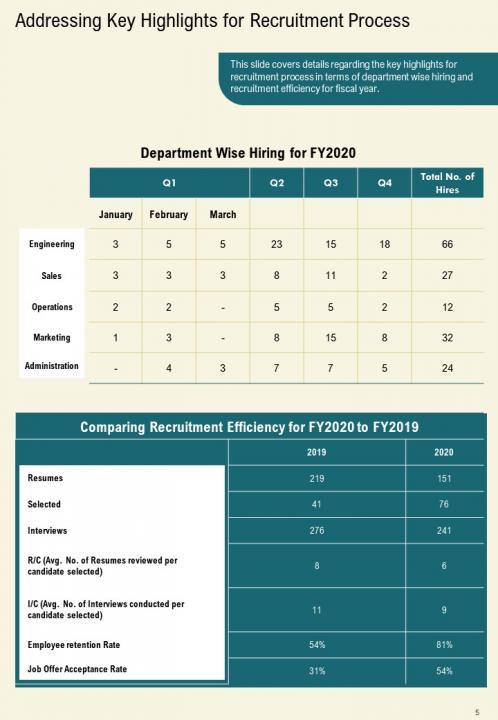
This is a prominent one—your yearly in-depth analysis. It covers everything from positions filled to the quality of candidates sourced, cost per hire, and time-to-fill data. It's essential to assess your overall recruitment performance and plan for the year ahead.
Benefits:
- Provides a comprehensive overview of annual recruitment efforts
- Helps set strategic hiring goals for the coming year
- Justifies recruitment budget and resource allocation
- Identifies long-term trends in hiring efficiency and effectiveness
Implementation tip: Start collecting data for this report throughout the year. Set up quarterly check-ins to ensure you track all necessary information and start identifying trends early.
Potential challenge: Presenting a year's worth of data in a digestible format.
Solution: Use data visualization tools to create impactful charts and graphs. Consider creating an interactive digital version of the report for easier navigation.
Process example: Many organizations use this report as part of their annual strategic planning process. They analyze the past year's recruitment performance to inform hiring goals and budget allocations for the coming year.
6. One-page recruitment metrics and status report template
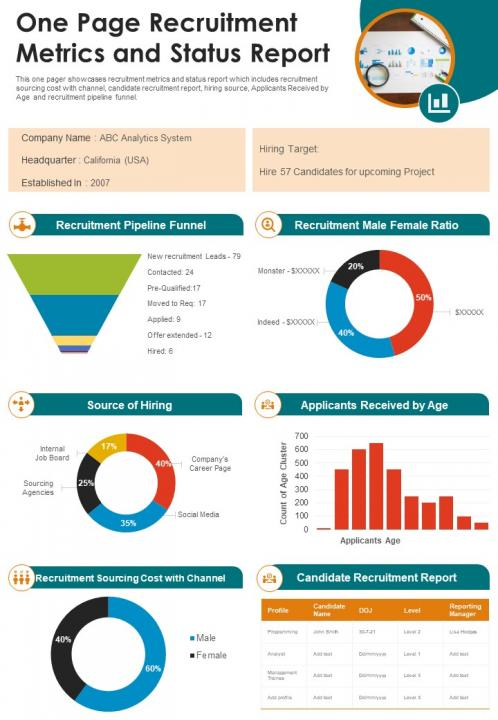
This is your executive summary. It condenses all your critical hiring data into a single, easy-to-digest page. It's a godsend for communicating with stakeholders and making quick, informed decisions when you need to look at key info at a glance.
You can use this in board meetings. It cuts through the noise and focuses on the metrics that really matter for strategic decision-making.
Benefits:
- Facilitates quick decision-making for busy stakeholders
- Highlights key recruitment KPIs at a glance
- Improves alignment between HR and other departments
- Supports data-driven conversations about hiring strategies
Implementation tip: Create a template with placeholders for key metrics. This allows for quick updates and ensures consistency in reporting over time.
Potential challenge: Deciding which metrics to include on a single page.
Solution: Survey key stakeholders to understand which metrics they find most valuable. Regularly review and adjust the included metrics based on current organizational priorities.
Process example: Some executives use this report as a quick reference during board meetings or investor presentations to give a snapshot of the company's talent acquisition efforts.
7. One-page business flyer for recruitment agency template
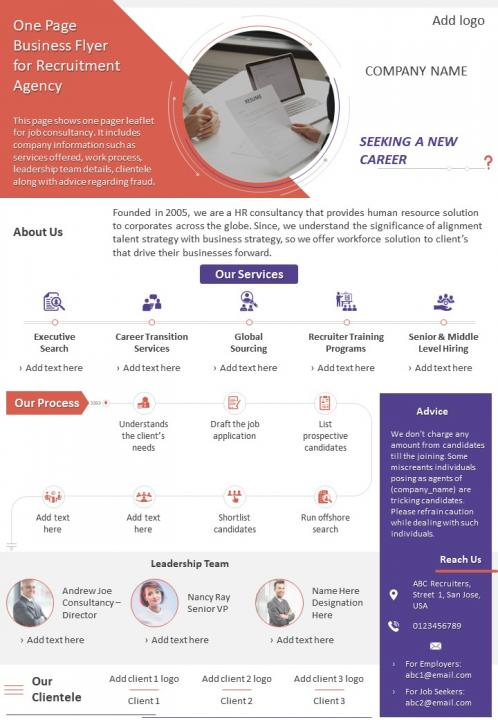
This one's a bit different—it showcases your recruitment capabilities to potential clients or candidates.
Agencies can use this to great effect when pitching to new clients. It's a quick, visually appealing way to highlight your strengths and success stories.
These templates are just the starting point. The real magic happens when you customize them to your specific needs and use them consistently to drive action. Remember, a good report doesn't just show what happened—it helps you shape what happens next.
Benefits:
- Highlights your agency's unique selling points
- Improves marketing efforts for recruitment services
- Provides a quick overview for potential clients or partners
- Helps standardize your agency's brand messaging
Implementation tip: Create multiple versions of this flyer tailored to different industries or types of roles you specialize in.
Potential challenge: Standing out in a crowded market of recruitment agencies.
Solution: Focus on unique selling points and back them up with concrete data or success stories. Regularly update the flier to reflect current market trends and your agency's evolving capabilities.
Process example: Recruitment agencies often use this flier as a leave-behind after initial meetings with potential clients. It serves as a quick reference for the client and a reminder of the agency's key strengths.
8. HR internal audit report
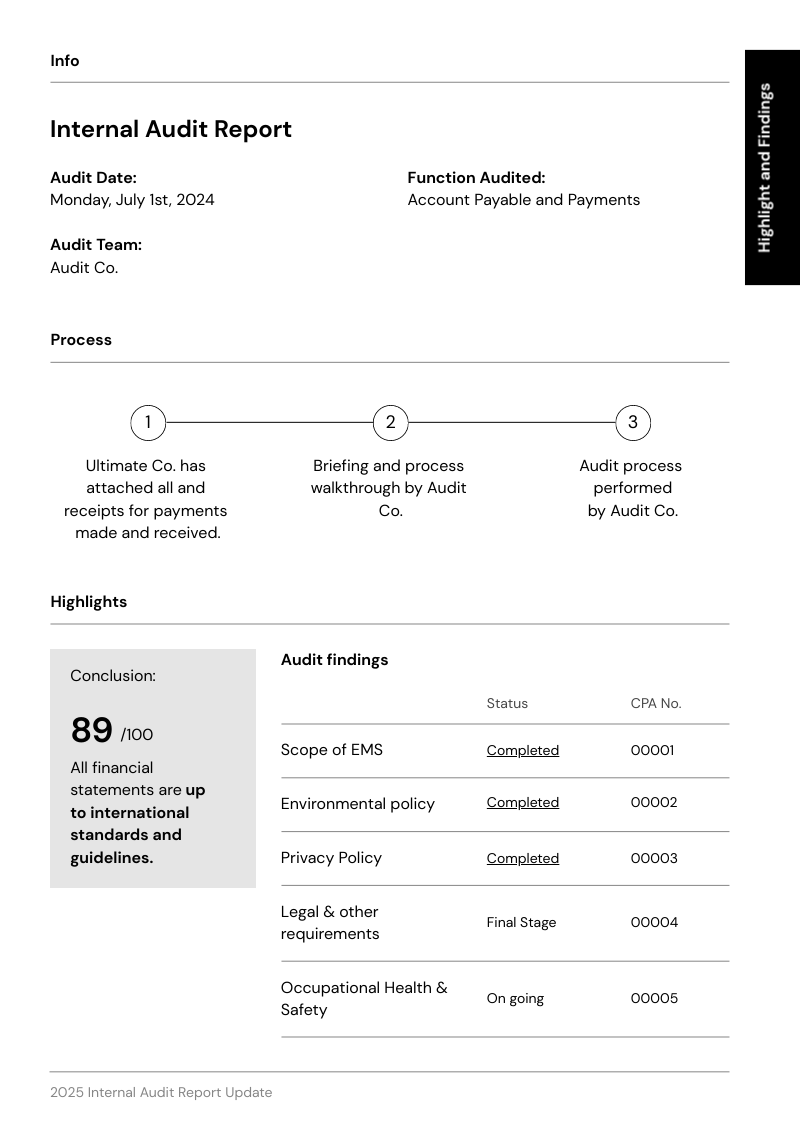
This template is a lifesaver when it comes to staying on top of compliance and best practices. It's not the most exciting report, but it's crucial for mitigating risks.
You can use this to uncover inconsistencies in your hiring practices across different departments. With a template like this one, you can standardize processes and avoid potential legal issues down the line. It's the kind of report that doesn't get much attention until it saves your bacon.
Benefits:
- Identifies potential compliance risks in hiring processes
- Ensures consistency in recruitment practices across departments
- Provides documentation for legal or regulatory inquiries
- Supports continuous improvement in HR operations
Implementation tip: Develop a checklist of areas to be audited and update it regularly based on changes in labor laws or company policies.
Potential challenge: Ensuring objectivity in the audit process.
Solution: Consider rotating audit responsibilities among team members or bringing in external auditors periodically to ensure a fresh perspective.
Process example: Many organizations conduct these audits quarterly, with a more comprehensive annual audit. The results are typically presented to senior leadership and used to drive process improvements and policy updates.
9. Employee satisfaction and retention report
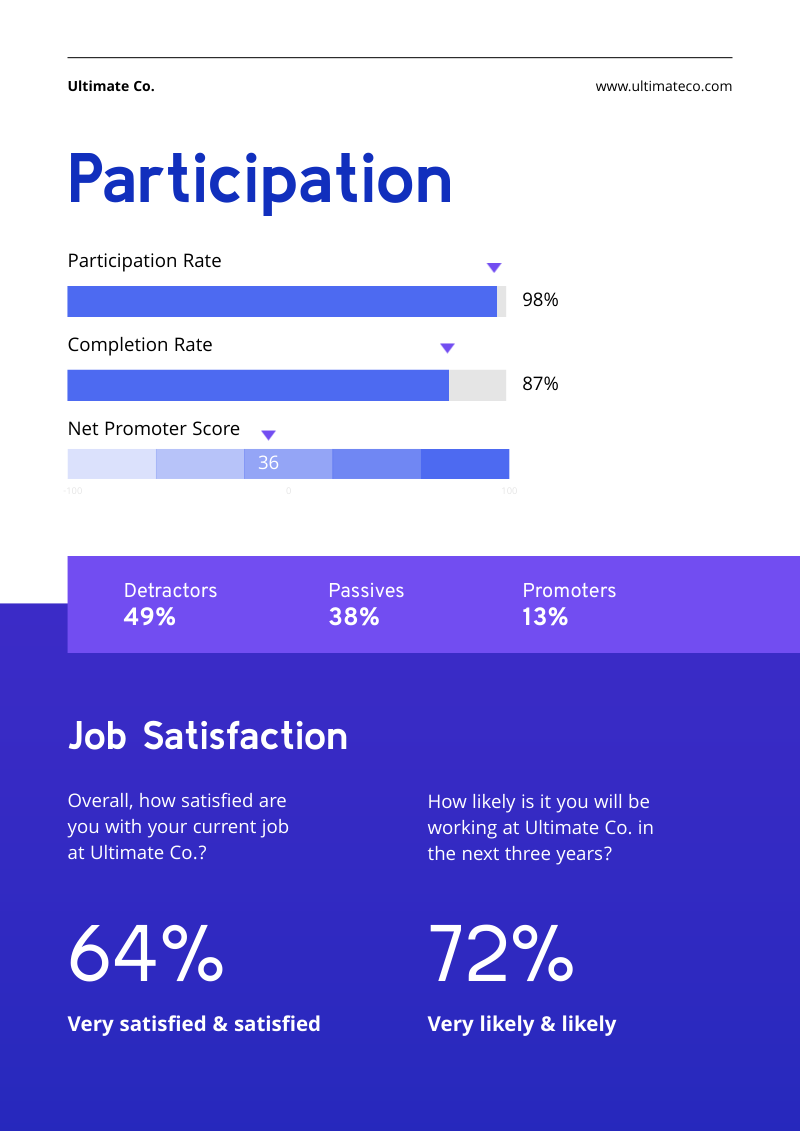
This one helps you understand your organization's pulse and retain the people you already have.
It consolidates survey findings to help you track engagement levels. It's key to improving retention and creating a better employee experience.
Benefits:
- Identifies factors influencing employee satisfaction and retention
- Supports data-driven employee experience improvements
- Helps predict and prevent turnover
- Provides insights for developing more effective retention strategies
Implementation tip: Use anonymous survey tools to encourage honest feedback. Consider implementing pulse surveys for more frequent but less comprehensive feedback.
Potential challenge: Low response rates to satisfaction surveys.
Solution: Communicate the importance of the survey to employees, make it easy to complete, and share how previous survey results led to concrete changes.
Process example: HR teams often present this report to department heads quarterly. They use the insights to develop targeted retention strategies and to inform decisions about benefits, professional development opportunities, and workplace policies.
10. HR roles and responsibility report
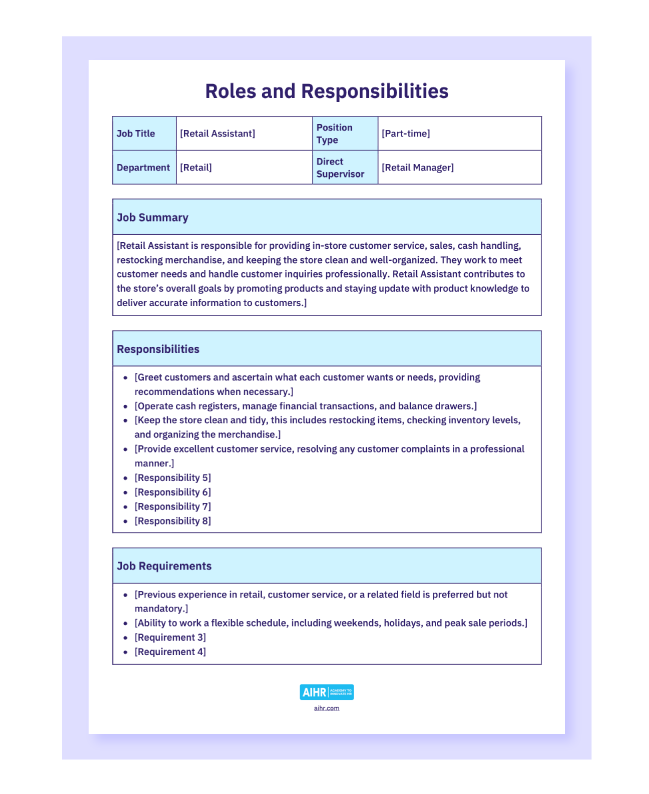
This template is fantastic for clarifying who does what within your HR team. It might seem basic, but you'd be surprised how often roles get muddy, especially in growing organizations.
With this, you can identify skill gaps and improve overall team efficiency. It's also great for onboarding new team members.
Benefits:
- Identifies skill gaps
- Clarifies roles and responsibilities
- Improves team efficient
- Aids in onboarding future HR hires
Implementation tip: Create a digital version of this report that can be easily updated as roles evolve. For consistency, consider linking it to job descriptions in your HRIS.
Potential challenge: Keeping the report up-to-date as responsibilities shift over time.
Solution: Schedule regular reviews of the report, perhaps quarterly, to ensure it accurately reflects current roles and responsibilities.
Process example: This report is often used during the onboarding process for new HR team members. It helps them understand the department's structure and where they fit in. It's also valuable during annual performance reviews to ensure job descriptions align with actual responsibilities.
Kula ATS helps you collect this data and understand what it means and what to do about it. That's the key to turning these reports from simple documents into catalysts for real change in your recruitment process.
Why should you use recruitment report templates?
Recruitment report templates can take a chaotic hiring process and turn it into a well-oiled machine. Let me break this down:
Simplified reporting methods
One of the main goals of Kula ATS was to get rid of those endless hours that recruiters spent putting together reports from different spreadsheets and systems. These templates can do that, too.
Therefore, you do not need to start from scratch whenever you want to give an update about your recruitment efforts with a well-designed process in place. You may need to fill in the data, but you still save time that can be spent with potential candidates and their respective hiring managers.
These templates also provide uniformity in reporting. It becomes easier to compare results across departments over time when everyone is on the same page.
However, what about communication?
Instead of trying to explain complex hiring data in an email, you’ve got a clear, visually appealing report that tells the story at a glance. Raw data can overwhelm even the most seasoned hiring managers. But present them with a well-structured report template, and their eyes light up with understanding and insight.
Improved accuracy and insights from data
Now, this is where things get really interesting.
Because you’ve systemized the whole process and reduced manual entry, you’re likely to make fewer errors. This is further reduced with a tool like Kula ATS, where you remove manual entry completely as you import data directly.
Templates encourage you to take a systematic approach toward information gathering, too.
Let’s consider a company whose attention was completely focused on time-to-hire. When they started using a source effectiveness template, they discovered that their quickest hires had the lowest performance rating.
This is one revelation that was just as shocking as it sounds. They could have never paired both metrics without a template that forced them to.
Improved decision-making capacity
Let’s take a pipeline report, for example. It does not merely indicate how many candidates are at every stage. What it does is identify bottlenecks and predict hiring based on conversion rates recorded previously. You can then plan for it rather than reacting to it.
From your source effectiveness reports, you may notice that employee referrals were consistently outperforming other channels. This can give you the green light to re-invest in their referral program by raising bonuses given per referral made. The outcome? Increased quality hires within the next quarter.
Kula ATS does you one better by letting your gamify referrals without leaving the platform.
Better tracking of recruitment measures
What gets measured gets managed. Templates make sure that you are consistently keeping track of metrics that matter the most to your organization.
It isn’t just about tracking more but tracking better. A well-designed template will drive your focus toward KPIs that correlate with business outcomes.
For example, it isn’t just how many people are hired, what also matters is their performance at 3, 6, and 12 months post-hire.
When monitoring consistent data over time, you start seeing patterns, come up with realistic targets, and compare them to benchmarks. Companies can change their hiring performance by understanding what good vs. great looks like in terms of industry and size.
Easier compliance and audit processes
Depending on your industry or location, you may need to meet some rigorous reporting expectations.
Rather than being caught off-guard trying to gather data from different sources all at once, use templates to bring everything together. Because you have been consistently using these templates, trends become easy to identify—something auditors adore.
However, meeting the auditor’s expectations isn’t the purpose of using templates. They allow you to identify potential areas of non-compliance well in advance.
Take our diversity and inclusion dashboard for example. It doesn’t just present current demographics but tracks variations over time.
You may think you’re doing great when it comes to gender diversity because the company has good overall figures for that metric. However, disaggregated by department using a DEI template, you may find that women are seriously underrepresented in technical roles.
Get organized with Kula’s recruitment templates
Recruitment report templates go beyond mere organization; they have the power to revolutionize your entire hiring process.
These templates provide invaluable insights that empower you to consistently make better hiring decisions.
But why stop there?
You can simply bypass the grunt work and manual data entry by upgrading to a tool like Kula ATS, where everything is automated from scratch.
To see for yourself, schedule a demo now!
